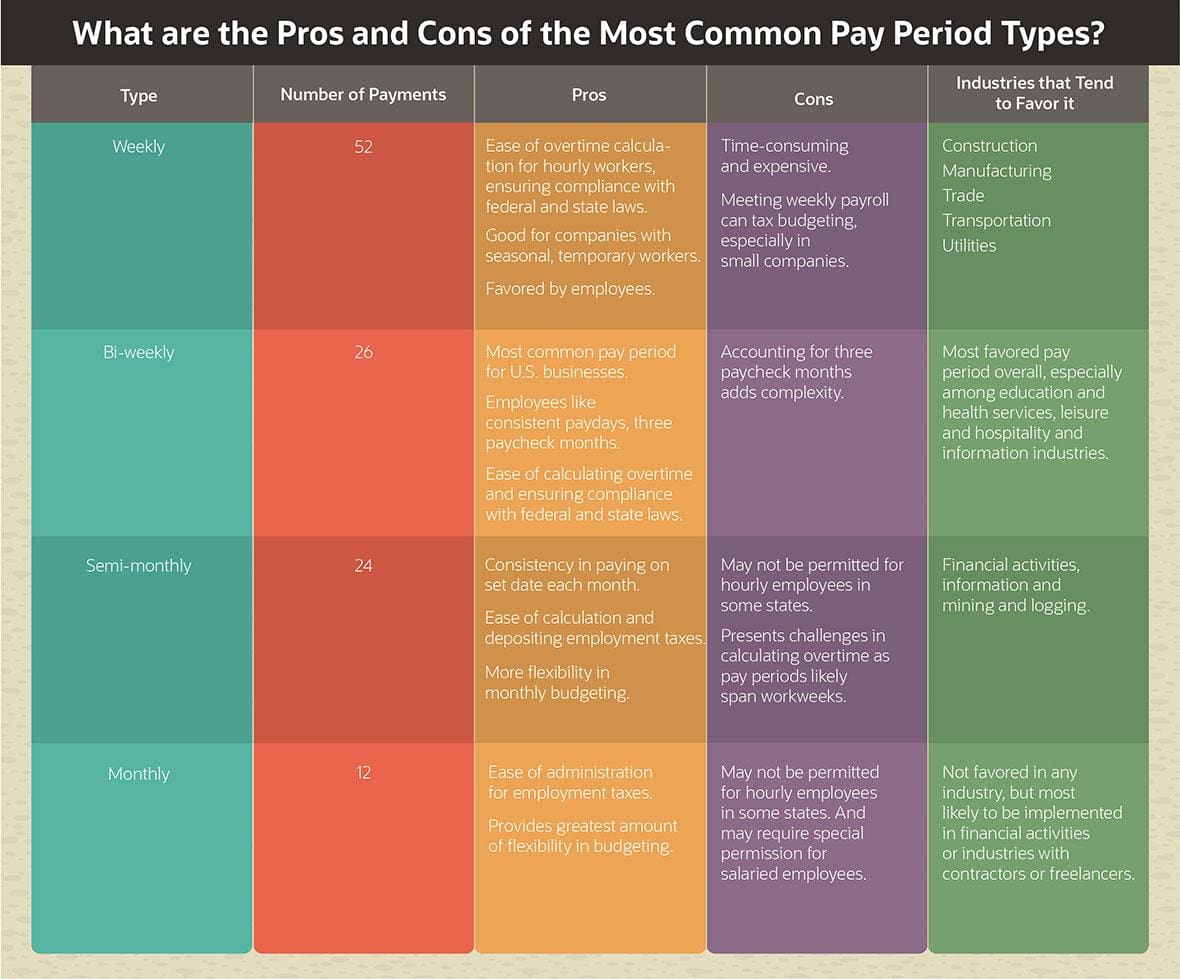How you manage the structures used to pay your employees is an important decision in running your business. Structuring your pay period in a well-thought-out-way can help you maintain compliance with tax and labor laws and consistently meet payroll obligations.
What Is a Pay Period?
A pay period is a time frame used to calculate earned wages and determine when employees receive their paychecks. Pay periods are fixed and most often recurring on a weekly, bi-weekly, semi-monthly or monthly basis.
It’s important to remember that the pay period is different from a workweek. The workweek is a federally-mandated, fixed period of 168 hours – or seven consecutive 24-hour periods – the employer must adopt to maintain compliance with the Fair Labor Standards Act (FLSA). A workweek can begin on any calendar day and at any time of that day, and the FLSA allows businesses to establish different workweeks for different employees or groups of employees. The main purpose of a workweek is to ensure overtime is paid fairly and correctly regardless of the type of pay period.
- Pay Period vs. Pay Date: The employee does not receive his or her check at the end of the pay period, but a number of days after it has concluded, which is known as the pay date. Requirements for pay dates are governed by states, not the FLSA. The number of days an employee must receive payment for earned wages after a pay period has ended varies by state. For instance, in Massachusetts, employees must be paid within six days of the end of the pay period. Human resources experts recommend leaving at least five days between the end of the pay period and the pay date. This allows time for payroll to be prepared properly and accurately regardless of holidays, vacations, unforeseen events and ensure accurate and timely reporting requirements are fulfilled.
Pay Period Types
Setting a pay period establishes order and keeps the business on track when it comes to tax withholdings for the IRS, calculating overtime for non-exempt employees and maintaining compliance with regulatory mandates. Within the confines of certain state laws, a business can pick a pay period of its choosing, including implementing multiple pay periods for different groups or types of employees (i.e., salary or hourly wage). Once in place, those pay periods must remain fixed for the calendar year.
-
Daily:
Most businesses, even very small businesses, historically did not opt to pay employees daily because of the time and complexity involved in calculating one-off tax withholdings and processing pay in 24-hours. There is, however, a new generation of payroll applications (sometimes called “instant pay” or “earned wage access” apps) designed to ease and enable daily pay periods. These services and apps allow employees to draw what they’ve already earned during a pay period without waiting for the established pay date, typically in exchange for a flat, per-transaction fee. The employee can only access wages they have already earned.
- Pros: Some three in four employees want access to their earnings before payday, and daily paydays can boost employee satisfaction and potentially mitigate financial stress: more than two-thirds of employees say they want access to wages earlier to cover bills and emergency expenses. Daily pay can entice temporary workers for jobs that are difficult to recruit for and provide the means to pay for the support structures – childcare, vehicle expenses and more – that allow employees to take on additional hours.
- Cons: Daily pay can be complex and costly to implement and administer, but instant pay apps are advancing in functionality to ease this process. Instant pay vendor DailyPay notes that some areas to be mindful of include who pays the advance (the employer or the instant pay vendor), how to withhold taxes, how to handle garnishment or reductions in arrears if the employee has already drawn down the wages, and how to issue pay stubs in compliance with reporting requirements.
- Pay cycles per year: There could be as many as 365 pay periods and paydays, but this will vary depending upon the employee.
-
Weekly:
The weekly pay period is a popular choice. The U.S. Bureau of Labor Statistics reports that more than one-third of worksites and establishments have a weekly pay period in place. That number is higher in companies with fewer than 50 employees and in construction (where it is the dominant pay period at 75.9%), manufacturing (45.4%) and trade, transportation and utilities industries (42.1%). Most businesses choose to align a weekly pay period with the workweek to ease the calculation and administration of overtime pay. When establishing weekly pay periods, employees are typically paid on the same day each week – such as every Friday.
- Pros: A weekly pay period when aligned with a workweek can make it easier to comply with FLSA overtime pay laws. Plus, hourly employees often prefer being paid on a weekly basis – and weekly pay periods can improve retention and engagement in roles that can experience high turnover, as well as provide an attractive structure for seasonal employees and those who work in industries that rely on a large portion of their wages from tips.
- Cons: Administering weekly payroll can be time-consuming and expensive. The latter is true especially if the company relies on a third-party vendor for payroll administration, which may charge fees every time it processes payroll. In implementing a weekly system, the company also needs to consider the frequency of ensuring proper tax withholdings, benefits administration, accounting for paid time off and holidays. A human resource management system (HRMS), helps you manage HR-related functions such as payroll processing. A HRMS can be a good option for processing payroll weekly because you’re not subject to fees for each pay period.
- Pay cycles per year: There are 52 pay cycles per year when a company adopts weekly pay periods.
-
Bi-weekly:
Bi-weekly is the most common length of pay period identified by the U.S. Bureau of Labor Statistics, with roughly 42% of private businesses opting to pay their employees every two weeks. As businesses grow, there is a propensity to adopt a bi-weekly pay period. Very small businesses – those with fewer than 9 employees – are the least likely to pay in this manner, while more than 70% of businesses with more than 1,000 employees pay on a bi-weekly schedule. In a bi-weekly pay period structure, pay periods end every other week and employees are paid every other week on a set day, typically Friday.
- Pros: Bi-weekly payrolls allow consistent paydays – for instance, employees will be paid on Friday of every other week. That consistency is appealing to employees, as is the fact that certain months have three paydays instead of two. In 2021, for example, employees paid their first check on Jan. 8 will get three paychecks in April and October. Bi-weekly pay cycles also make the calculation of overtime pay easier for non-exempt employees – as each consecutive seven-day period can be aligned with the workweek, and overtime calculated on that basis. This also eases the calculation of overtime when it comes to holidays, paid time off and sick time, if offered by your company.
- Cons: Bi-weekly pay periods do introduce some complexity into the bookkeeping process because certain months will have three pay periods and paydays instead of two. Tracking and projecting cash flow is crucial to ensuring that the business can cover and process the “extra” payroll in those months.
- Pay cycles per year: Because there are 52 weeks in a year, there are 26 pay periods and pay dates a year in a bi-weekly pay schedule.
-
Semi-monthly:
With semi-monthly pay periods, pay dates come twice a month on the same days each month – often either on the 1st and the 15th or the 15th and the last day of the month. If that date lands on a weekend, payday is typically the Friday before. This is the third most common option for businesses – coming in ahead of monthly, pay periods but behind bi-weekly and weekly. Industries most likely to use semi-monthly pay periods include mining and logging, financial activities and information systems.
- Pros: Semi-monthly payrolls win on consistency. Payroll is run on the same date each month and can more easily adapt to odd-numbered day months and leap years. Paychecks for salaried employees are usually in equal amounts, making it easier to plan for payroll and helping employees better anticipate earnings. The structure also imparts some level of flexibility in overall budgeting because payroll needs to be paid only twice a month. This can also ease administration of benefits and the deposit and withholding of employment taxes.
- Cons: Semi-monthly pay periods can present challenges in FLSA compliance for non-exempt employees because workweeks may overlap pay periods, making it more challenging to calculate overtime. And some states, such as Massachusetts, prohibit paying hourly employees on a bi-monthly or monthly basis.
- Frequency of pay cycle: Employees on a semi-monthly pay period have 24 pay dates per calendar year.
-
Monthly:
Only 5.4% of the establishments surveyed overall by the U.S. Bureau of Labor Statistics pay their employees once a month. Monthly pay periods are most common in very small businesses with fewer than 9 employees – of which 10% reported paying their employees once a month.
- Pros: Monthly pay periods are easy for the business to administer in terms of tax withholdings, benefits and budgeting, and they can work well for businesses with salaried employees. Monthly pay periods give businesses more flexibility with cash flow, and it simplifies budgeting for future positions.
- Cons: Monthly payroll is extremely complex to administer with hourly wage employees and/or non-exempt employees and may not be allowed in some states. For instance, Texas allows monthly paydays only for employees exempt from overtime provisions of the FLSA. In Connecticut, employers are required to pay most hourly employees a “regular payday, scheduled at a minimum weekly.” A longer interval is permitted only by approval by the labor commissioner.
- Frequency of pay cycles: With monthly pay periods, an employee will receive a check 12 times in a calendar year.

-
Fixed length:
Some industries may have unique pay periods that don’t fit the traditional weekly, bi-weekly, semi-monthly or monthly cycles. The most prevalent example is education – where administrative staff and teachers often do not work in the summer months. As a result, some states allow public school districts to give teachers an option in which the annual salary is distributed over 21 pay periods – over roughly their 10 months of work – while also offering an option to receive payment according to a standard bi-weekly pay period (or 26 pay periods). Often, the district will pay out the additional five pay periods in a lump sum – issued early in the summer.
-
Custom:
Sometimes employees will need to receive payment outside of the defined pay cycle determined by the pay period – such as when they resign from a job or are terminated. Maintaining compliance in paying employees during these events can be complex. There is no federal law requiring final payment immediately, but some states have laws governing when an employee must receive their final check in these instances. For example, terminated employees in Colorado must be paid immediately, allowing for some exceptions. Employees terminated by their employer in Connecticut must receive wages in full no later than the next business day after the discharge.
There are some circumstances that may need to be accommodated outside of the pay periods tracked and identified by the Wage and Labor Division of the Department of Labor. These include but are not limited to the following.
Pay Period Examples
Let’s take a look at how an exempt, salaried employee making $62,400 a year would receive her paychecks over the course of the year. Watch how the amount in each check will differ according to the structure chosen. It’s important to note that this calculation does not account for employment tax or benefit withholdings.
| Paycheck | Number of Pay Periods | Pay date | |
|---|---|---|---|
| Weekly | $1,200 | 52 | Every week |
| Bi-weekly | $2,400 | 26 | Every other week |
| Semi-monthly | $2,604 | 24 | Twice monthly |
| Monthly | $5,196 | 12 | Once a month |
Now, let’s look at how two popular pay periods would play out with a non-exempt employee paid an hourly wage. If she works more than 40 hours in a given workweek, she’ll need to be paid overtime. Let’s say the workweek starts on a Sunday, and to further simplify, the month in this example begins on a Sunday. The employee worked 42 hours from the 1st through the 7th and 38 hours from the 8th through the 14th. Overtime for each workweek must be calculated separately – meaning that even if the organization adopts a bi-weekly pay period, it cannot average those hours together to get 40 each week.
At her wage of $31/hour, the overtime rate (time and a half $31/hour) is $46.50. Calculating 40 hours at $31/hour and two hours at $46.50/hour, the employee earns $1,333 during week one. She works no overtime during week two and earns $31/hour for 38 hours for a total of $1,178.
If the employee is paid on a bi-weekly pay period, simply add the amounts from the weekly pay periods together to get the bi-weekly pay period amount of $2,511. Note, this does not account for tax withholdings or benefits.
How Pay Periods Are Determined
An organization selects the pay period structure that best fits the type of work it does, the needs of its employees, the labor laws where the company does business and other factors.
It’s also important to note that the business can choose different pay periods for different types of employees. It’s not uncommon for an enterprise to pay its hourly employees weekly or bi-weekly and its salaried employees semi-monthly or even monthly. But the pay period must be applied consistently during the calendar year to wages earned to stay compliant. Organizations that must remain FLSA-compliant have at least two employees and an annual dollar volume of sales or business done of at least $500,000, along with hospitals, businesses providing medical or nursing care for residents, schools and preschools and government agencies. Even when there is no enterprise coverage, employees are protected by the FLSA if their work regularly involves interstate commerce.
Choosing the Best Pay Period for Businesses
With 42% of private companies selecting bi-weekly, that is the most common pay-period duration in the U.S. Certain industries also tend to favor certain pay periods – for instance, in construction, weekly pay periods are the dominant type of pay period, while financial and information technology industries are more likely to implement semi-monthly pay periods. Data from the U.S. Bureau of Labor Statistics shows that the smallest establishments tend to exhibit the most variety in paying their workers.
In considering what pay period to enact for your business, compliance and cash flow figure in heavily. Selecting a pay period (or periods) first requires taking into account the types of employees working at your company — exempt (salaried) and non-exempt (hourly) — and any unique state laws governing how they can be legally paid. Remember, in some states, it is illegal to pay hourly workers on a monthly or even semi-monthly basis. A company also needs to pay close attention to its cash flow cycles in order to best determine how it can efficiently meet payroll. New and smaller companies may have difficulty meeting payroll obligations because of cash flow concerns if they need to process it several times a month.
7 Things to Consider When Choosing Pay Periods
With that all in mind, select the right pay period for your business by considering factors such as state regulations, the cost of running payroll and other factors, including the following.
-
Employment laws and regulations:
Federal regulations only mandate payment for wages earned, they don’t specify when and how wages should be paid. Some states have more stringent laws for when and how hourly employees must be paid. Carefully review all wage and labor laws in the states you do business before deciding on a pay period structure. -
Workweeks:
Managing payroll for small businesses can be challenging. Aligning the workweek with the pay period simplifies overtime calculations and makes payroll that much easier to process. Under the FLSA, each business is required to define a workweek — a fixed period of 168 hours, or seven consecutive 24-hour periods. Each workweek stands alone in calculating overtime for non-exempt employees. For instance, if an employee is paid bi-weekly and works 30 hours in one workweek and 50 hours in the next, she must be paid for 20 hours of overtime in the second workweek at a rate no less than time and one-half her regular rate of pay. If it’s legally permissible to pay an hourly employee on a semi-monthly schedule, it’s possible that workweeks will overlap pay periods, meaning there is also the possibility that overtime pay will span different pay periods.
-
Payroll costs:
Understanding the costs associated with the process is a common payroll concern. Costs include compensation plus all employer-paid employment taxes and the employer-paid portion of benefits. Total payroll costs can account for as much as 50%-60% of a business’s total operating costs. Additionally, there are costs associated with the processing of payroll, especially if it’s done through a third-party payroll service which typically charge for every payroll cycle.
-
Overtime:
Considering whether your employees are exempt or non-exempt from the FLSA will help you maintain compliance with overtime requirements and help narrow down your choices for pay periods. A business with lots of non-exempt hourly employees may be better off choosing a pay period that eases that calculation and payment of overtime. Semi-monthly pay periods can present challenges in terms of complying with state laws for paying hourly employees, as well as accurately and efficiently calculating overtime pay.
-
Employee needs:
Take into account what pay period structure might help with employee satisfaction. About two-thirds of employees say they wish they had access to earned wages earlier in order to cover bills and emergency expenses. More than half say financial stress distracts them from their work. And most employees (70%) would prefer more frequent payment and say that it would be difficult to meet financial obligations if their next paycheck was delayed a week.
-
Withholdings:
The IRS requires certain withholdings from employees’ paychecks. Calculating it is complex and guidance changes – and payment must be made on a defined schedule – either monthly or semi-monthly, depending on the business’s total tax liability. The IRS released a new version of the W-4 form in 2020 aimed at reducing complexity and increasing transparency and accuracy of the withholding system. It replaces the worksheets in the old form with questions designed to make accurate withholding determination easier for the employee, and it has new guidance for employers on ensuring enough federal income tax is withheld.
Withholdings are complex and the regulations and processes are known to change. That’s why many companies choose to use payroll software to manage taxes and withholdings. The platforms can calculate withholdings and process payroll, all while making sure you stay compliant and account for things like complex pay structures and multi-state business.
-
Reporting:
Companies are responsible for recording and reporting requirements for compliance with labor laws and employment taxes. Be mindful of how the pay period(s) you choose will help you best adhere to reporting requirements. The FLSA requires employers keep records for each covered, non-exempt worker, which must log accurate information about the hours worked and the wages earned. Among the list of details a company must maintain is the total wages paid per pay period and the date of the payment and pay period covered. The IRS requires that employers report wages, tips and other compensation paid to an employee by filing the required form(s). Employers that withhold federal income tax or social security and Medicare taxes must file Form 941, Employer's Quarterly Federal Tax Return, each quarter. This includes withholding on sick pay and supplemental unemployment benefits.
Common Pay Period Mistakes to Avoid
Mistakes with payroll can result in fines and deeply unsatisfied workers. In fiscal year (FY) 2019, the U.S. Department of Labor recovered $322 million in back wages owed to workers. And an average $1,120 was due per employee in back wages in FY 2020. Some common payroll mistakes include the following.
- Failure to calculate and pay overtime correctly. The majority of collection from the Department of Labor is because employers didn’t pay time overtime. Unpaid overtime amounted to $186 million in recovered wages in FY 2019.
- Failure to deposit employment taxes in accurate amounts and on time. One of the biggest payroll challenges is accurate withholding calculations for regular and supplemental pay. At the beginning of the calendar year, a business must decide which deposit schedule for social security and Medicare taxes to use – either monthly or semi-weekly — based on the total tax liability reported on Form 941 (the quarterly federal tax return). Penalties are levied for late payments and increase according to the time frame they remain unpaid.
- Failure to keep accurate records. The FLSA requires employers to keep three years of pay records, and some states may require even longer. Accurate records also help ensure employees are properly classified as exempt, non-exempt or independent contractors so your business can maintain compliance with labor and tax laws.
Manage Pay Periods and Payroll with Payroll Software
Managing payroll is exceedingly complex and is absolutely crucial to get correct. It’s not something that should ever be left to spreadsheets. With payroll software, you can configure pay periods and account for different periods for various classes of employees. It automates the calculation of earnings, deductions, company contributions, taxes and paid time off. It can also process payment via direct deposit – ensuring employees get paid sooner and more securely than by paper check. Cloud-based payroll software is regularly updated so you can be confident you’re following the most current tax and labor laws at federal and state levels. All of this saves time and reduces errors. Many payroll departments are shifting their systems toward cloud-based solutions. In 2014, only 14% of companies processed payroll with cloud-based software — that leapt to 39% by 2018.
Human capital management (HCM) is the process your business uses to hire, train and retain your workforce. Benefits of a well-managed HCM strategy include higher employee satisfaction, less turnover and a more efficient business. Managing pay and payroll is an important part of HCM, and many people turn to HCM software that includes payroll processing to help. HCM is one of multiple core business software applications.
The most successful HCM software solutions connect with other modules from disparate areas of your business through what’s known as enterprise resource planning (ERP) By storing it all in one digital space, you’re better able to manage your data, reporting and understand how one area of the business interacts and affects another.
Another benefit of payroll software is it can help you keep track of metrics that show the performance of your team, like the number of payroll errors and the cycle time to process payroll, so you can set goals and improve processes. These key performance indicators (KPIs) are displayed in simple-to-understand dashboards that can be made available to your team and other key stakeholders in the business.
Selecting the pay period or pay periods for your business may seem like a simple decision, but it has a significant impact on your company and employees. The decision sets your business up to fulfill one of its most important obligations – paying the people it relies on. Managing different pay periods, accounting for complex pay structures and staying compliant with state and federal laws makes processing payroll complex. HCM software can help you more efficiently manage the process, as well as integrate with other areas of your business and provide vital KPIs to track the performance of your team and help employees manage HR-related documentation, such as taxes and personal contact details.
Simplify
HR and Payroll
Pay Period FAQs
How does a bi-weekly pay period work?
With a bi-weekly pay period, employees will receive their paycheck every other week on the same day of the week — often a Friday. Bi-weekly pay periods mean there are 26 pay cycles a year – and two months will have three pay periods. Bi-weekly is the most common length of pay period identified by the U.S. Bureau of Labor Statistics, with 42% of U.S. private establishments opting to pay their employees every two weeks.
What are the four most common pay periods?
The four most common pay periods are: weekly, bi-weekly (every two weeks), semi-monthly (twice a month on a set date) and monthly (once a month).
How many weeks is a pay period?
The number of weeks in a pay period depends on the pay cycle adopted by the employer. In a weekly pay cycle, there are seven days. In a bi-weekly pay period, employees get paid every two weeks. In a semi-monthly pay cycle, employees receive payment roughly every 15 days, unless the payday falls on a weekend, in which case payroll is typically processed the day before. In a monthly pay period, the employees are paid once a month – usually on the last day of the month.
How many pay periods are in 2021?
The number of pay periods always stays the same with monthly and bi-monthly. But the number of times payroll is processed with a weekly or bi-weekly pay period structure can change depending on the year – including if it begins on a Friday (like 2021) or includes an extra day (leap year).
There are 53 Fridays in 2021 – meaning that if the organization adopted a weekly or bi-weekly pay period and paid employees on Jan. 1, there is a possibility that employees receive an “extra” paycheck. If that’s the case, on a bi-weekly pay schedule, the three paycheck months are January, July and December. For organizations that processed their first payroll of the year the following Friday, April and October will be the three paycheck months.









